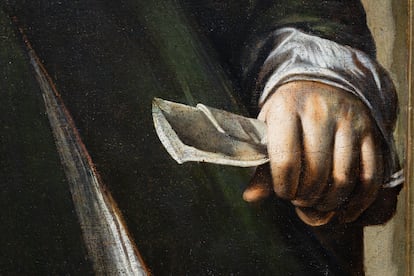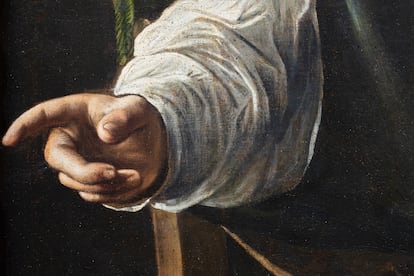If it is difficult to imagine that in 2024 a caravaggiothis year there are already two. After the Behold the Man exhibited in Madrid in May, in Rome a painting by the Italian genius that had never before been exhibited to the public is on display in Rome from today in the Palazzo Barberini museum, until February 23. It is about the Portrait of Monsignor Maffeo Barberinidated between 1599 and 1603, a work only known to experts and only attributed in 1963, and which until now had remained hidden from the public in a private collection in Italy. Its owner had never given permission to display it.
“It has been very exciting. In this work we see many things, but seeing this painting again, perhaps the first, with the team, was exciting. We were ahead for seven hours the first day. It is the caravaggio that everyone wanted to see, but it seemed impossible,” says Thomas Clement Salomon, the director of the Gallerie Nazionali di Arte Antica, in conversation with EL PAÍS. “These days I have seen quite a few colleagues moved, scholars crying, because it was from a lifetime that they tried to do this,” he says.
The portrait of this young priest Barberini, who was then about 30 years old, like the artist himself, and who later became Pope Urban VIII, dominates the darkness of a room in the palace he built for his family when he was named pontiff. In this lavish building, one of the most beautiful in Rome, full of masterpieces, with a staircase by Bernini and another by Borromini, this long-awaited work now emerges in chiaroscuro in which the hand of Michelangelo Merisi, called Caravaggio.
It is not signed, because he did not sign his paintings, but it is unanimously attributed to the Milanese artist by all the main experts, since the famous critic Roberto Longhi did it for the first time in 1963. Since then researchers have been secretly visiting it and everyone They have been nodding. Technicians at the Gallerie Nazionali have carried out new diagnostic tests these months that have also corroborated the authorship.
How was it finally possible to convince its owner? “There was no particular reason for me not to lend it, it is a fascinating story, we do not know the reasons, they have tried many times, for years, this time we have been very determined, we believed that the time had come, and something has changed ”says Clement Salomon. The event anticipates the major Caravaggio exhibition that the same museum will open in March 2025.
The indications of the master’s technique that the researchers point out are displayed in the painting: the chromatic experimentation, the way of placing the figure diagonally with respect to the background, the shape of the hands, the luminosity of the skin and the particular technique used. time to paint the eyes, with a brushstroke of white leadthe white color made with basic lead carbonate, which gives intensity to the look. But above all the most exciting thing, indicate the organizers of the exhibition, is that the painting shows the beginning of Caravaggio’s style, it is his first immersion in the shadows and in the contrasts between light and darkness that would end up forging his seal and would make famous. It inaugurates the beginning of his maturity, of his last and prodigious decade of life.

This exhibition is not only important for displaying the painting for the first time, but it also fills a gap in the artist’s known work: hardly any portraits of him remain, despite the fact that in Rome he painted many of figures from the Curia and friends and acquaintances, because they have been lost. “They are very rare,” says Thomas Clement Salomon. “They are counted on the fingers of one hand: the Portrait of Alof de Wignacour in the Louvre; the portrait of the knight of Malta, from the Palazzo Pitti in Florence… They are really few. And, for example, the Portrait of Fillide Melandroni It was in Berlin and was destroyed during the war.”
This painter with a dangerous and quarrelsome life, who had to flee Rome after killing a man and being sentenced to death, scandalized with his way of painting. His innovation in portraits was to make them “without similarity,” according to his biographers. In other words, he wasn’t worried that they didn’t look like the model. Already in his time he was considered a genius and those who commissioned him knew what they were getting into. Sometimes the result was celebrated or reviled. In any case, Longhi stated that with this canvas “the modern portrait was opened.”
For the museum director, “a more static and mannerist portrait ended, and with this painting a strong action began, which anticipates the baroque portrait.” Maffeo Barberini’s right hand points to something outside the frame, as if the protagonist was addressing someone outside the scene, and with his left he holds a letter.

The painting, according to researchers, was in the hands of the Barberini family for centuries, but around 1935, when the entire collection was dispersed, it was sold on the antique market. Track of him was lost until he reappeared in Rome, without documentation, and Longhi later revealed his whereabouts. In fact, it was a friend of his, the critic Giuliano Briganti, who was the first to see Caravaggio’s hand in the painting, but he gave him the attribution.
There is a second portrait by Maffeo Barberini, owned by a Florentine noble family, whose attribution is more disputed. It has always been assigned to Scipione Pulzone, and later some critics have done so to Caravaggio, but there is a division of criteria. With it now on display in Rome, no one has any doubts.

